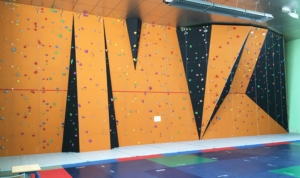design recommendations

Width: as wide as possible, as the width determines the number of active users. (1.20 m wide = one route for a trio of students: 1 climber and 2 spotters), ideally 12 simultaneous routes, 15 m wide.
Height: 5 m to 7 m minimum.
Width of the climbing span: 1.20 m.
Configuration: 1 incline, 1 overhang of 1.20 m, 1 positive incline board for beginners, plus vertical and inclined surfaces.
All routes must be visible simultaneously to the supervisor.


Support: can be attached to any support: concrete, cinder block, glued laminated timber, metal frame or free standing
Number of 3D holds: 6/m2 to 9/m2 for 2 to 3 climbing routes in overlapping colours.
Landing surface: standard NF P90/312 for rope walls and NF EN 12572-2:2017 for bouldering walls. Indoors = removable landing mats 5 cm or 10 cm thick or cushioned flooring / outdoor floor = rolled gravel 10/15 calibre, 30 cm to 40 cm deep, or cushioned flooring.
Clearance zone: 3 m above the height of the largest overhang.
Safety: draw a red line at a height of 3 m indicating the height not to be exceeded without rope (traverse work). In case of a multisport area, use a curtain or a separation net.
Other equipment / comfort: minimum lighting intensity = 300 lux, uniform / heating and ventilation temperature: 14°C (hot air must not accumulate at the top of the climbing wall).
our service on request:
- design assistance
- free advice / quote without obligation
- assistance in the drafting of specifications
- engineering & technical information (support resistance, standards information, etc.)
Our field experts are at your disposal for any quote.

pyramide tips
A 3 m wide positive incline board is recommended for beginners.
Use a curtain, preferably opaque, to separate the climbing wall from other sports areas.
Consider the climbing equipment needed for the activity.
Plan out routes using coloured holds, from beginner-level to experienced, respecting the rule of 2/3 – 1/3 (2/3 of the routes for beginners / experienced climbers of level 3 to 5a and 1/3 of the routes for expert levels of 5b and above, without exceeding 6b.)
- yellow for beginner routes – level 3 (inclined surface)
- grey for beginner routes – level 4a (inclined or vertical surface)
- red for beginner routes – level 4b (vertical surface)
- pink for beginner routes – level 4c (vertical surface)
- green for intermediate routes – level 5a (vertical surface)
- orange for intermediate routes – level 5b (inclined surface)
- blue for advanced routes – level 5c (inclined surface)
- purple for advanced routes – level 6a (inclined surface)
- black for expert routes – level 6b / 6c and 7a (inclined surface)
Use track numbering and signage to indicate the level of difficulty by hold colour.